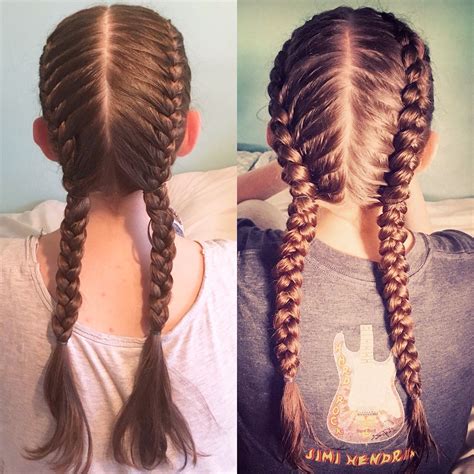Introduction
The world of hairstyling boasts a vast array of intricate and captivating braids, with Dutch and French braids standing as two of the most popular choices. These versatile styles offer a timeless elegance and can elevate any look, from casual to formal. However, despite their similar appearance, there are key differences between Dutch and French braids that can impact your styling experience and overall aesthetic.

Dutch Braid vs. French Braid
Basic Technique:
Dutch Braid:
- Starts from the crown of the head.
- Involves crossing the bottom strand over the middle strand instead of under it (as in a French braid).
- Creates a raised, or “outside-in” effect.
French Braid:
- Starts closer to the hairline.
- Involves crossing the top strand underneath the middle strand.
- Creates a flat, or “inside-out” effect.
Appearance:
Dutch Braid:
- Voluminous and lifted.
- Provides a more textured and intricate look.
- Adds height and fullness to the hair.
French Braid:
- Flatter and more polished.
- Appears more elegant and refined.
- Can showcase hair accessories like ribbons or beads.
Suitability:
Dutch Braid:
- Ideal for thick, voluminous hair.
- Can hold its shape well in active environments.
- Recommended for those seeking a more casual or sporty look.
French Braid:
- Suitable for all hair types, including fine or thin hair.
- Adds length and structure to shorter hair.
- Perfect for formal occasions or when a more polished appearance is desired.
Pros and Cons
Dutch Braid
Pros:
- Creates a voluminous and eye-catching effect.
- Adds height to the hair.
- Easy to achieve with practice.
Cons:
- Can be slightly more challenging to master for beginners.
- May be less comfortable to wear for extended periods.
- Can pull on the hair if braided too tightly.
French Braid
Pros:
- Flattering and versatile style.
- Adds length and structure to hair.
- Can incorporate hair accessories for added charm.
Cons:
- May be more time-consuming to braid.
- Can appear flat on fine hair.
- Can be more difficult to maintain than a Dutch braid.
Pain Points and Motivations
Pain Points:
- Tightness: Braiding hair too tightly can cause pain and discomfort.
- Time-consuming: French braids can be more challenging and time-consuming to create.
- Unflattering on certain hair types: Dutch braids may not be suitable for fine hair, while French braids may appear flat on thick hair.
Motivations:
- Style: Braids offer a stylish and versatile way to elevate any look.
- Convenience: Braided hair can be a low-maintenance option for busy individuals.
- Hair protection: Braiding hair can help prevent tangles and breakage.
Common Mistakes to Avoid
- Braiding too tightly: Avoid pulling the hair strands too tautly, as this can cause discomfort and damage.
- Starting the braid too low: For a French braid, start braiding closer to the hairline to create a more polished look.
- Not using hair products: Apply a light hairspray or mousse to tame flyaways and enhance the hold of the braid.
- Neglecting to secure the end: Tie off the end of the braid securely with an elastic band or ribbon to prevent it from unraveling.
FAQs
- Which braid is more secure? Dutch braids are generally more secure and can hold their shape better than French braids.
- Can I sleep with a braid in my hair? Yes, braiding your hair before bed can help prevent tangles and breakage. However, avoid sleeping with a braid that is too tight.
- How often should I wash my hair if it’s braided? If you’re wearing a braid for an extended period, aim to wash your hair every 2-3 days to prevent dirt and oil buildup.
- Can I braid my hair if it’s wet? Avoid braiding wet hair, as it can be more fragile and prone to breakage.
- Which braid is more appropriate for a wedding? French braids are often preferred for weddings due to their elegant and polished appearance.
- Can I add extensions to my braid? Yes, you can incorporate hair extensions into both Dutch and French braids for added length and volume.
